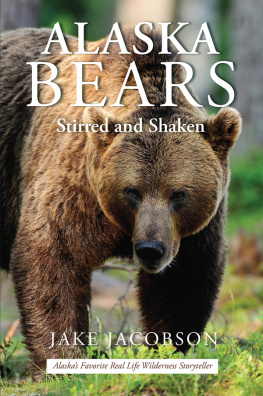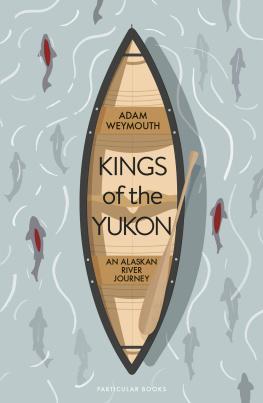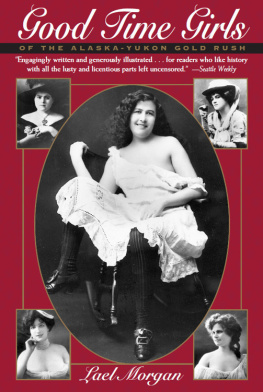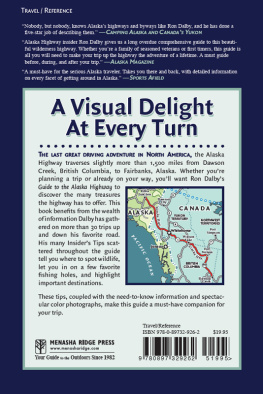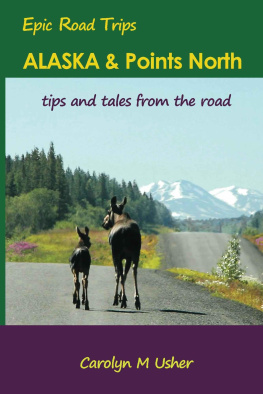Alaska-Yukon Place Names
James W. Phillips
Northwest Corner Books, an imprint of Epicenter Press
Copyright 1973 by the University of Washington Press Printed in the United States of America
No part of this publication may be reproduced or transmitted in any form or by any means, electronic or mechanical, including photocopy, recording, or any information storage or retrieval system, with permission in writing from the publisher.
Library of Congress Cataloging in Publication Data: Phillips, James Wendell. 1922Alaska-Yukon place names.
Bibliography: p.
1. Names, GeographicalAlaska.
2, Names, GeographicalYukon Territory. I. Title. F902.P45 917.98003 73-1776
Print ISBN: 978-1-941890-02-8
eBook ISBN: 978-1941890-03-5
Smashwords Edition
Dedicated to the only real treasure that accrued
to my grandfather from his participation
in the AlaskaYukon Gold Rush of 1898
a daughter, Goldie Nugget McLaughlin Phillips
Preface
This alphabetically arranged dictionary details the origins and meanings of names for cities, towns, and a representative sampling of remote native (both Eskimo and Indian) villages in the state of Alaska and the Yukon Territory. In addition, it includes the name sources of many geographical features that, in my opinion, are of historical or current news significance.
For the further edification of visitors and residents new to the Northland, this book also covers the way points along the inland and marine routes throughout Alaska, the Yukon Territory, and the pertinent coast and northern sections of British Columbia. To heighten understanding of the region, its history, and its development, many less prominent place names are included because they explain the flora and fauna (Fireweed Creek, Ptarmigan, Whale and Walrus islands), geology and topography (Gold Creek, Platinum, Silver City, Pingaluk River), and exploration and settlement. (Bering sea, Malaspina and Muir glaciers, Cook Inlet, Mount Vancouver, Sixtymile River, Hydaburg, Watson Lake).
The selection of communities is based on the 1970 census reports, 1972 postal directories, and current gazesetteers issued by various agencies of the governments involved in the Northland. To assure that a broad spectrum of tourist attractions was provided for readers, another major source of place/feature names has been the where-to-go, what-to-see pamphlets and guides published by both government and private travel agencies, tour operators, airlines steamships, and ferries.
Several entities in a given area frequently have the same name derived from the same source, such as Juneau (city, mountain, harbor, ice field, island, lake) and Taku (arm, community, glacier, harbor, inlet, mountain, point, range). In the interest of brevity, only one entry that of the community or, in the absence of a settlement, the major geographic feature-appears in the text on the assumption the reader will extend the generic definition appropriately. In instances where place names commence with a geographical term such as cape; lake, mount, or point, those of communities are entered in the text by such designations (Point Hope); those of geographical features are listed under their main name (Laberge, Lake).
Often the origin or evolution of a name has been explained by a variety of accounts, some of which are apocryphal. In all such cases I have given what is in my judgment the best documented, most logical explanation. Where no definition currently exists (or one has not come to any attention), the entry so states, while providing whatever information concerning the site is available.
A phonetic pronunciation guide is a part of each entry, except in the case of common or obvious words. It should be noted, however that pronunciation occasionally varies from locale to locale and between old-timers and newcomers) particularly in the case of Anglicized names of Eskimo, Indian, and Russian origination. The pronunciations shown in this book were coordinated by individuals officially versed in regional place names and represent the most accepted general usage at the present time.
Although archives have been searched and local experts contacted, corrections and clarifications in definitions and pronunciation are inevitable (and expected). Hence, readers with information on places mentioned or omitted are invited to send documentation to the author in care of the publisher so that future editions can he revised and expanded.
Obviously, in a work of this scope and complexity, the author is indebted to a variety of research sources. Prime references included other historians and the archives of museums, libraries, and historical societies throughout the Pacific Northwest. Without the cooperation and expertise of postal and civic officials, scholars, lay experts, and sourdoughs who granted me interviews and responded to query letters, this book certainly could not have been completed.
The publications and personal assistance of Donald J. Orth, director of the Geographic Names Section, Geological Survey, U.S. Department of the Interior, and president of the American Name Society, have been invaluable. In addition, I would like to acknowledge the very special assistance provided by Phoebe Harris and her history department staff at the Seattle Public Library. Other history specialists who provided material (often their own research notes) included Roy S. Minter, vice-president, corporate communications, White Pass & Yukon (railway) Route; aviation writer Stephen E. Mills; Michael E. Dederer, vice-president of Jay Rockey Public Relations, Inc., special consultants to the State of Alaska; and Professor Charles J. Keim, College of Arts and Letters, University of Alaska.
I am appreciatively indebted to three official representatives of the State of Alaska: Lee C. Kramer, manager of the Seattle Information Office of the Department of Economic Development; and Phyllis Nottingham and Robert N. De Armond of the State Historical Library in Juneau.
The Yukon government officials who rendered special service to me were Karl L. Crosby, manager, and Marjorie Robertson, counselor, Yukon House, Vancouver, B.C., and territorial archivist Brian Spiers, Whitehorse Library-all representatives of the Yukon Department of Travel Information.
JAMES W. PHILLIPS
Introduction
Place namesthe titles of communities and geographic features that currently appear on mapsprovide a mute, but richly description account of the history of the State of Alaska and the Yukon Territory. Bestowed by native inhabitants, explorers, and adventurers, the names chronologically detail the impact of various ethnic cultures and nationalistic groups upon the vast Northland.
Native place names show the sectors initially occupied by the Eskimos, the Aleuts, and the several diverse linguistic groups and tribes of Indians that inhabited the region. Russian names and the Slavic transliteration of native names recall the invasion of tsarist fur traders in the Aleutian Islands and the coastal areas of Alaska. Intermixed with the Russian titles are a host of English and a sprinkling of Spanish names assigned by naval explorers from Britain and Mexico (New Spain). Inland the Indian names are interspersed with those affixed by traders and voyageurs of the Hudsons Bay Company and by the adventures of various nationalities, most often Americans, who prospected for gold.
Later, waves of scientific explorersAmerican, British, Canadian military men, government surveyors, and visiting scholarscovered the hinterland, mapping remote areas, confirming and consolidating earlier data, and bestowing names. Patriotic by personality and sponsorship, these men utilized the names of superiors, colleagues, and notables of their respective governments. They varied the procedure occasionally by honoring a renowned scientist of another country or by affirming a name already bestowed by one of their earlier foreign counterparts. But in the main the names they laid upon the land continued the nationalistic pattern. Hence, the place names of Alaska and the Yukon graphically explain the regions historyits exploration, its settlement, and the phases of development or use that it has undergone.


